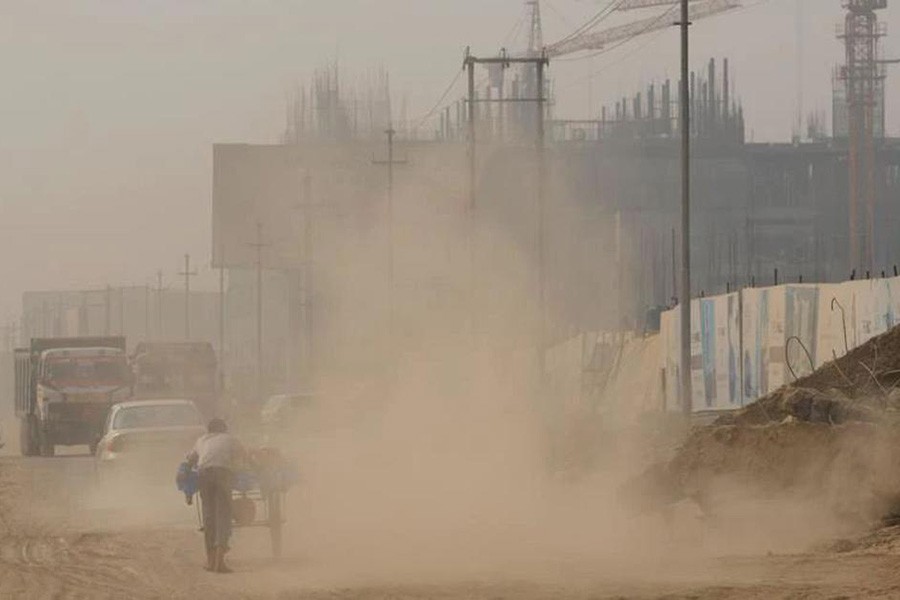Although it is common knowledge that pollution has many facets, not all of which are easily traceable, one of its worst and most visible aspects is dust pollution that hardly spares anyone. Essentially an urban peril, it is going on unabated despite alarms being raised from various quarters, including healthcare experts and environmentalists. The fact, however, is that pollution caused by dust is more than an environmental hazard, in that it is directly linked with public health.
According to a report of World Health Organisation (WHO) released months back, Dhaka's air quality ranked as the third most polluted in the world. Another WHO report, published in 2016, says over 37,000 Bangladeshis die annually from diseases related to air pollution, caused mainly by dust. There was a time when it was only in the dry season that swirls of dust moved about all over the places. But these days, even in the rainy season, there is hardly any respite. Worst, the long lingering summer with its scorching heat is rendered unbearable by clouds of dust hanging around like mounds of fog, taking heavy toll on humans who have no choice but to inhale the foul air.
There are, of course, several potential sources of the persistent presence of dust in the air. Roads are, no doubt, the main source. Dust kicked up by vehicles travelling on roads make up 33 per cent of air pollution in our region, according to experts. Road dust consists of deposits of vehicle and industrial exhausts, particles from tire and brake wear, from paved roads or potholes and from construction sites.
Road dust is a significant source contributing to the release of harmful substance into the atmosphere. Control of road dust is a significant challenge in urban areas, and also in other locations with high levels of vehicular traffic. The quality of air mixed with dust drastically deteriorates when it comes into contact with industrial waste, smoke from brick kilns and so on. Construction sites also contribute hugely to the diffusion of dust particles in the air. Lately, air pollution in the capital has assumed a serious proportion due to huge activities now in progress for construction of elevated expressway and metro rail. Needless to mention, while these facilities for public transportation are a must and should have been in place long ago, precautions and measures for health safety are shockingly missing. Frequent reports in the media on the reckless manner in which earth digging is done without the least regard for its harmful effects have failed to reach the authorities.
People with heart or lung diseases and other chronic diseases are at increased risk from dust and particle pollution. Studies have shown that when particle levels are high, older adults with undiagnosed disease are likely to be exposed to various ailments. A study revealed that number of chest and lung-related diseases have shot up more than 30 per cent in the country over the past five years. Increased level of air pollution is affecting millions all over the country, though it is the urban dwellers who are the worst victims. Many opt for wearing face masks to filter the air from harmful substance. However, it remains to be seen whether the device is of any help.
Freeing the air from dust, particularly dust mixed with noxious particles, is indeed a highly challenging task in our country. This is because road digging is a round-the-year affair, not only in the capital but in most cities. The sewerage and water supply departments, just to mention the two prominent utility service agencies, make it a never-ending job to keep digging the roads all the year round. It seems these agencies are under no legal or professional obligation to follow any guidelines in trying to restrict or at least lessen the dust menace. In advanced countries, there are mechanised methods to suppress road dust. Street sweeper vehicles equipped with powerful vacuum cleaners or water sprayers are commonly used.
The reason why the problem has reached such a scale is because dust pollution has never been considered as one warranting action. To put it in its true perspective, it didn't figure as a problem at all. Now that environmentalists and the media are at it, blaming the authorities-- the diggers in particular-- for utter negligence in undertaking their activities, it looks like a bit of public awareness has been created. But mere public awareness is self-defeating as the public has no recourse left to them to repel the dusty business. So, who do they look up to? The City Corporations have manifestly proved what they are capable of -- flaunting their failures as successes in almost all areas they are duty-bound to perform. The Department of Environment (DOE) apparently has no tooth to bite. Reports have it that the DOE consults from time to time with different agencies, including Rajuk, City Corporations, Local Government Engineering Department, Public Works department, Housing authorities, Titas Gas and Real Estate and Housing Association of Bangladesh, to sign deals with builders and constructors to prevent dust pollution while constructing buildings, roads and implementing other development projects. But there is nothing in sight as of now.
Something has to be done. We don't expect any highly sophisticated mechanism to fend off the dust menace, but there must be government regulations, preferably in the form of law laying out procedures to contain the havoc. Can we hope to see a move in tackling the situation?


